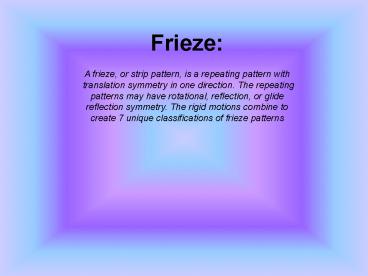Frieze: - PowerPoint PPT Presentation
1 / 16
Title:
Frieze:
Description:
The first frieze group, F1, contains only translation symmetries. Mathematician John Conway created ... Meander Frieze. San Giorgio Maggiore. Venice, Italy ... – PowerPoint PPT presentation
Number of Views:660
Avg rating:3.0/5.0
Title: Frieze:
1
Frieze A frieze, or strip pattern, is a
repeating pattern with translation symmetry in
one direction. The repeating patterns may have
rotational, reflection, or glide reflection
symmetry. The rigid motions combine to create 7
unique classifications of frieze patterns
2
The first frieze group, F1, contains only
translation symmetries. Mathematician John Conway
created names that relate to footsteps for each
of the frieze groups. According to Conway, F1 is
also called a HOP.
3
The second frieze group, F2, contains translation
and glide reflection symmetries. According to
Conway, F2 is called a STEP.
Cha cha cha.
4
The third frieze group, F3, contains translation
and vertical reflection symmetries. Conway named
F3 a SIDLE.
Tile FriezePalacio de VelazquezParque de
RetiroMadrid, Spain
5
The fourth frieze group, F4, contains translation
and rotation (by a half-turn) symmetries.
According to Conway, F4 is called a SPINNING HOP.
Meander FriezeSan Giorgio MaggioreVenice,
Italy
6
The fifth frieze group, F5, contains translation,
glide reflection and rotation (by a half-turn)
symmetries. Conway calls F5 a SPINNING SIDLE.
MosaicNuestra Senora de la
AlmundenaMadrid, Spain
7
The sixth frieze group, F6, contains translation
and horizontal reflection symmetries. Conway
named F6 a JUMP.
CeilingMezquitaCordoba, Spain
8
Finally, the seventh frieze group, F7, contains
all symmetries (translation, horizontal
vertical reflection, and rotation). According to
Conway, F7 is named a SPINNING JUMP.
Back of a BenchBanos de la Maria de
PadillaReales AlcazaresSeville, Spain
9
Wallpaper Pattern
A wallpaper pattern (also known as a plane
crystallographic group) is a pattern with
translation symmetry in two directions. It is,
therefore, essentially an arrangement of friezes
stacked upon one another to fill the entire
plane. Any particular wallpaper pattern is made
up of a combination of the following
symmetriesrotation, reflection, and glide
reflection.
10
Since wallpaper patterns use one more dimension
than frieze patterns, there are more combinations
of symmetries that a wallpaper pattern may have.
11
Like friezes, wallpaper patterns have rotocenters
about which a basic unit can be rotated. The
smallest angle that a fundamental domain can be
rotated determines the order of the rotocenter of
a wallpaper pattern. For example, if a
fundamental domain can be rotated by a 1/2-turn,
the pattern is of order 2. The only possible
orders for the rotocenters of wallpaper patterns
are 2, 3, 4, and 6. In addition to rotation,
wallpaper patterns have reflections and glide
reflections. These symmetries rely on mirror
lines in the plane of the pattern. Unlike in
friezes, it is possible to have glide lines that
are not mirror lines. Like frieze patterns,
wallpaper patterns can be divided into
classifications using a simple flow chart (see
the figure below). In 1891 E.S. Fedorov proved
that there are exactly 17 possible wallpaper
patterns
12
This diagram shows the rotational symmetry of the
different types of wallpaper patterns.
13
The wallpattern cm has no rotation, but has
reflection and glide-reflection.
14
The wallpattern p1 has no rotation, no
reflection, and no glide-reflection
15
The likes and differences between frieze and
wallpaper patterns.
16
this is the end of my presentation!! thanks for
viewing































